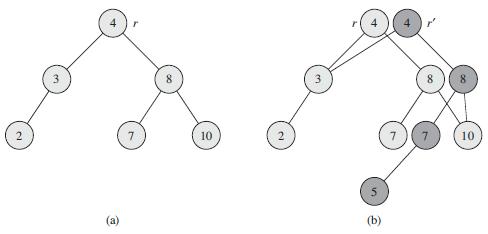During the course of an algorithm, we sometimes find that we need to maintain past versions of
Question:
During the course of an algorithm, we sometimes find that we need to maintain past versions of a dynamic set as it is updated. We call such a set persistent. One way to implement a persistent set is to copy the entire set whenever it is modified, but this approach can slow down a program and also consume much space. Sometimes, we can do much better.
Consider a persistent set S with the operations INSERT, DELETE, and SEARCH, which we implement using binary search trees as shown in Figure 13.8(a). We maintain a separate root for every version of the set. In order to insert the key 5 into the set, we create a new node with key 5. This node becomes the left child of a new node with key 7, since we cannot modify the existing node with key 7. Similarly, the new node with key 7 becomes the left child of a new node with key 8 whose right child is the existing node with key 10. The new node with key 8 becomes, in turn, the right child of a new root r€² with key 4 whose left child is the existing node with key 3. We thus copy only part of the tree and share some of the nodes with the original tree, as shown in Figure 13.8(b).
Assume that each tree node has the attributes key, left, and right but no parent.

Figure 13.8
a. For a general persistent binary search tree, identify the nodes that we need to change to insert a key k or delete a node y.
b. Write a procedure PERSISTENT-TREE-INSERT that, given a persistent tree T and a key k to insert, returns a new persistent tree T€² that is the result of inserting k into T.
c. If the height of the persistent binary search tree T is h, what are the time and space requirements of your implementation of PERSISTENT-TREE-INSERT? (The space requirement is proportional to the number of new nodes allocated.)
d. Suppose that we had included the parent attribute in each node. In this case, PERSISTENT-TREE-INSERT would need to perform additional copying. Prove that PERSISTENT-TREE-INSERT would then require Ω(n) time and space, where n is the number of nodes in the tree.
e. Show how to use red-black trees to guarantee that the worst-case running time and space are O(lg n) per insertion or deletion.
Step by Step Answer:

Introduction to Algorithms
ISBN: 978-0262033848
3rd edition
Authors: Thomas H. Cormen, Charles E. Leiserson, Ronald L. Rivest





